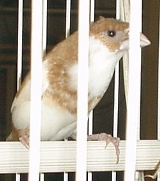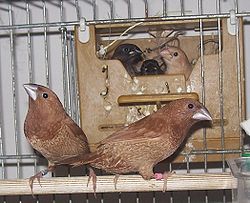
Society finch
Encyclopedia

The Society Finch or Bengalese Finch (elsewhere), Lonchura striata domestica or L. domestica, is a popular cage bird not found in the wild.
It is a member of the estrildid finch family. Many authorities call it a domestic form of the White-rumped Munia
White-rumped Munia
The White-rumped Munia or White-rumped Mannikin , sometimes called Striated Finch in aviculture, is a small passerine bird from the family of waxbill "finches"...
(known in aviculture as the Striated Finch), at least probably, though some state that it originated as a hybrid of this species with others in the genus Lonchura. A DNA study found that it was more closely related to the White-rumped Munia than either bird is to the Zebra Finch
Zebra Finch
The Zebra Finch, Taeniopygia guttata, is the most common and familiar estrildid finch of Central Australia and ranges over most of the continent, avoiding only the cool moist south and the tropical far north. It also can be found natively in Indonesia and East Timor...
, the Chestnut-breasted Munia
Chestnut-breasted Munia
The Chestnut-breasted Munia , also known as the Chestnut-breasted Mannikin or Bully Bird , is a small brown-backed munia with a black face and greyish crown and nape. It has a broad ferruginous breast bar above a white belly. The species is found in Australia, New Caledonia, Indonesia, and Papua...
, or the "Silver Bill" (presumably the Indian Silverbill
Indian Silverbill
The Indian Silverbill or White-throated Munia is a small passerine bird found in South Asia that was formerly considered to include the closely related African Silverbill . This estrildid finch is a common resident breeding bird in the dry regions of the Middle East and South Asia...
), indicating that it originated from the White-rumped.
Bengalese Finches are well adapted to captivity and the company of humans. They breed well and are good foster parents for other finch-like birds.
While two males may not get along without other company, it has been found the best "pairing" for fostering is to use two males, this works better than either two females or a male and female pairing. Two males will usually accept eggs, or even partly grown young without any hesitation.
These birds like to be close together and tend to all roost in one nest if kept in a group. In an aviary
Aviary
An aviary is a large enclosure for confining birds. Unlike cages, aviaries allow birds a larger living space where they can fly; hence, aviaries are also sometimes known as flight cages...
they lay eggs and crowd into a single nest, interfering with incubation (which is performed by the female and lasts 16 days) or damaging the eggs. Thus they breed better if kept as single pairs in individual breeding boxes. This sociability is also responsible for their American name of "Society Finch".
They are cheerful little birds that are quite easy to look after. They are also quite easy to breed provided they are, of course, adequately sexed. Obtaining a female-male pair can present a difficulty because both sexes look exactly the same at first glance. However, it is possible to determine gender by behavior since males tend to display to impress and court females. The best way of using this method to sex Bengalese is to place a single bird in a small cage and completely isolate it from its own kind [both sight and hearing] for several hours; then introduce another Bengalese to the cage. If the first bird is a male it will immediately display to the newcomer. Unfortunately this does not necessarily mean the introduced bird is a female. But if the first bird does not display it is almost certainly a hen.
However, a quicker and more sure method of sexing is to compare both the head width [in a line across the top of the head between the eyes], and the shape of the under-side of the beak. The male has a much broader head than the female; and the male's under-beak [where the beak meets the feathers of the neck] is a "V' shape and the hen's more rounded like the bottom of the letter "U". In both these methods the two birds should be held side by side to compare.
They are generally given a diet of seeds, such as millet
Millet
The millets are a group of small-seeded species of cereal crops or grains, widely grown around the world for food and fodder. They do not form a taxonomic group, but rather a functional or agronomic one. Their essential similarities are that they are small-seeded grasses grown in difficult...
s and canary seed, and greens. They will not usually take live-foods, but it has been found they will often accept house fly pupae, which they crack like seed. This is particularly useful if they are being used to foster species that require a high protein component to be successfully reared.
In experimental biology
Society Finches have been used extensively in research on imprintingImprinting
Imprinting may refer to:* Genomic imprinting , a mechanism of regulating gene expression* Imprinting , in psychology and ethology* Molecular imprinting, in polymer chemistry...
and on bird vocalizations, often comparing the structure of their songs to syntax
Syntax
In linguistics, syntax is the study of the principles and rules for constructing phrases and sentences in natural languages....
.

